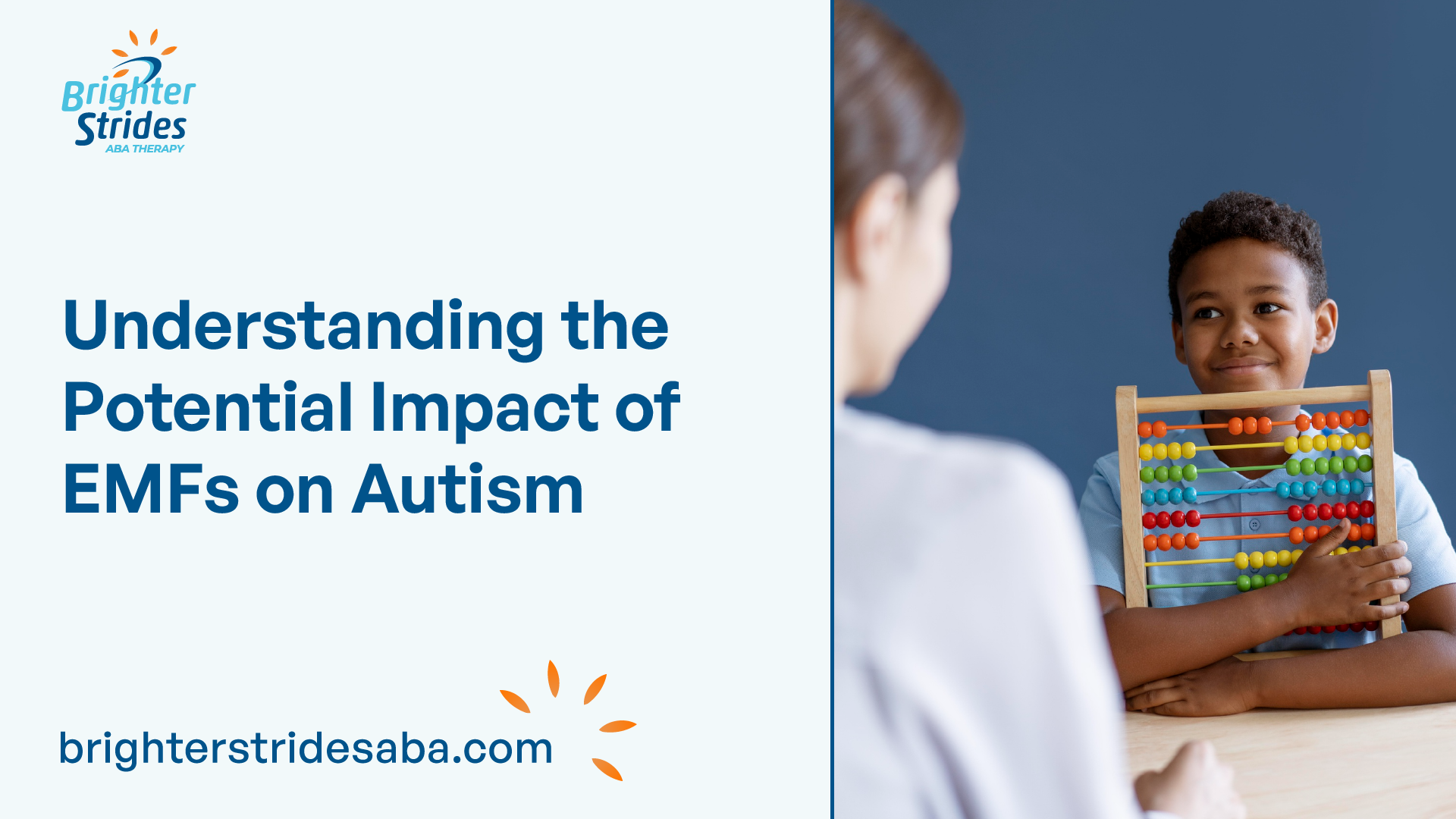Exploring EMFs and Autism
In the quest to understand the potential impact of electromagnetic fields (EMFs) on autism, it is important to first gain an understanding of autism spectrum disorder (ASD) and its prevalence.

Understanding Autism Spectrum Disorder
Autism, or Autism Spectrum Disorder (ASD), is a neurodevelopmental disorder that affects communication, behavior, and social interaction. Individuals with ASD may exhibit a wide range of symptoms and varying degrees of impairment. The exact causes of autism are not yet fully understood, but it is believed to be a complex condition with contributions from genetic, environmental, and neurological factors.
The Prevalence of Autism
The prevalence of autism has been on the rise in recent years. According to the Centers for Disease Control and Prevention (CDC), approximately 1 in 36 children in the United States is diagnosed with autism. This increase in autism diagnoses highlights the need for ongoing research and understanding of the factors that contribute to its development.
Understanding the prevalence of autism is crucial in order to address the needs of individuals with this condition and provide appropriate support and interventions. As research continues, scientists and healthcare professionals strive to unravel the complexities of autism and gain insights into potential contributing factors, including the role of EMFs.
By exploring the relationship between EMFs and autism, we can delve deeper into the ongoing research findings and the debate surrounding their potential causal relationship. This exploration will provide a comprehensive understanding of the topic and shed light on its implications for individuals with autism.
Investigating the EMF-Autism Connection
As the concern regarding the potential impact of electromagnetic fields (EMFs) on autism grows, researchers have been investigating the relationship between the two. In this section, we will explore the research findings on EMFs and autism, as well as the ongoing debate surrounding the causal relationship.
Research Findings on EMFs and Autism
Several studies have been conducted to examine the potential link between EMFs and autism. One study published in the journal Scientific Reports observed that mice exposed to EMFs during pregnancy had offspring that exhibited behaviors similar to autism. However, it is important to note that this study was conducted on animals, and the findings cannot be directly extrapolated to humans.
While some studies have suggested a potential relationship between prenatal or early-life exposure to EMFs and an increased risk of autism, the research in this area is still developing, and the findings are not yet conclusive [1]. The current evidence does not support a direct causal relationship between EMF exposure and autism.
The Debate on Causal Relationship
The scientific community is engaged in a debate regarding the causal relationship between EMF exposure and autism. While some studies suggest a potential association, many experts argue that the existing research is limited and inconclusive. It is crucial to approach this topic with caution and recognize that correlation does not necessarily imply causation.
It is important to consider that individuals with autism spectrum conditions (ASCs) may exhibit similarities in biological effects with electromagnetic frequency and radiofrequency exposures (EMF/RFR), such as oxidative stress, inflammation, and changes in neurotransmitter levels [3]. However, the specific impact of EMFs on individuals with autism is still a subject of ongoing research.
With the rise in reported ASCs coinciding with the introduction of wireless technologies, there is a call for rigorous investigation into potential links between ASCs and EMF/RFR. It is crucial to conduct comprehensive research to further understand the potential impact of EMFs on individuals with autism and establish evidence-based guidelines for public exposure standards and precautionary practices.
While further research is needed to determine the precise relationship between EMFs and autism, it is important to approach this topic with an open mind and continue exploring the potential connections.
Biological Mechanisms at Play
To understand the potential impact of electromagnetic fields (EMFs) on autism, it is important to explore the underlying biological mechanisms involved. Several biological factors have been identified in individuals with autism spectrum conditions (ASCs) that show parallels with the physiological impacts of EMF exposure.
Oxidative Stress and Free Radicals
Many studies have found evidence of oxidative stress and free radical damage in individuals with ASCs. Oxidative stress occurs when there is an imbalance between the production of free radicals and the body’s ability to neutralize them. Free radicals can cause damage to cells and DNA. In individuals with ASCs, elevated oxidative stress has been observed, indicating potential cellular dysfunction.
Cellular Stress Proteins and Antioxidants
Cellular stress proteins and antioxidants play a crucial role in maintaining cellular health. Studies have shown deficiencies of antioxidants, such as glutathione, in individuals with ASCs [4]. Glutathione is an essential antioxidant that helps protect cells from oxidative damage. The imbalance of cellular stress proteins and antioxidants may contribute to the disrupted homeostasis observed in ASCs.
Intracellular Calcium Levels
Elevated intracellular calcium levels have been observed in individuals with ASCs. The underlying causes of this increase in intracellular calcium may be genetic or a result of inflammation or environmental exposures. Calcium plays a crucial role in various cellular processes, including neuronal signaling. Dysregulation of calcium levels can disrupt normal brain function and contribute to the development and manifestation of autism.
These biological mechanisms provide insights into the potential impact of EMF exposure on autism. The physiological disturbances observed in ASCs, such as oxidative stress, cellular stress proteins, and altered calcium levels, share similarities with the effects of EMF exposure. However, it is important to note that further research is needed to fully understand the relationship between EMFs and autism. The available evidence suggests a possible association, but additional comprehensive studies are required to establish a causal link and define safe exposure standards.
Impact of EMFs on Neurodevelopment
When considering the potential impact of electromagnetic fields (EMFs) on neurodevelopment, several key factors come into play. This section will explore the effects of EMFs on brain function and neuronal activity, disruption of cellular communication, and the potential effects on neurotransmitter function.
Brain Function and Neuronal Activity
Studies have suggested a parallel between the biological effects of EMF exposures and the characteristics observed in individuals with autism spectrum conditions (ASCs). Research has identified oxidative stress, cellular stress proteins, and deficiencies of antioxidants in people with ASCs, which aligns with the effects of EMF/RFR exposures that disrupt homeostasis [3].
It has been observed that individuals with ASCs often experience changes in brain and autonomic nervous system electrophysiological function, sensory processing, seizures, and sleep disruption. Interestingly, these symptoms can also be induced by EMF/RFR exposure, potentially exacerbating the challenges associated with ASCs.
Disruption of Cellular Communication
EMFs have the potential to disrupt cellular communication, which is critical for proper neurodevelopment. Elevated intracellular calcium levels have been associated with ASCs and may be linked to genetics, inflammation, or environmental exposures. This suggests a potential connection between EMF/RFR exposures and the observed increase in intracellular calcium levels.
Effects on Neurotransmitter Function
Neurotransmitters play a crucial role in brain function and communication between nerve cells. Research has shown that EMF/RFR exposures can affect neurotransmitter function, potentially impacting neurodevelopment. The changes in neurotransmitter function may contribute to the symptoms associated with ASCs and warrant further investigation into the potential links between EMFs and neurodevelopmental disorders [3].
Considering the evidence suggesting a parallel between the effects of EMF exposures and the characteristics observed in individuals with ASCs, it is crucial to conduct rigorous research to explore the potential links between EMFs and neurodevelopmental disorders. The rise in reported ASCs, coinciding with the introduction of wireless technologies, calls for new public exposure standards and precautionary practices to mitigate any potential disruptions to biological processes. Further investigation is necessary to fully understand the relationship between EMFs and neurodevelopment and to develop appropriate guidelines to protect vulnerable populations.
Research Challenges and Future Directions
As researchers continue to investigate the potential link between EMFs and autism, they face several challenges in study design and variability. These challenges contribute to the mixed findings and lack of consensus within the scientific community. However, these challenges also highlight the need for more comprehensive research to establish a clearer understanding of the relationship between EMFs and autism.
Study Design and Variability
The research on the potential link between EMFs and autism has utilized various research designs, including epidemiological studies, case-control studies, and laboratory experiments. However, the variability in study results can be attributed to differences in sample size, study design, measurement techniques, and the complexity of the relationship between EMFs and autism. The variability in findings makes it challenging to draw definitive conclusions and establish a causative relationship.
To address these challenges, future studies should aim for larger sample sizes to increase statistical power and reduce the impact of random variation. Additionally, standardized measurement techniques and protocols should be employed to ensure consistency across studies. Longitudinal studies that follow individuals over time can provide valuable insights into the potential cumulative effects of EMF exposure on autism risk.
The Need for Comprehensive Research
The complexity of autism as a neurodevelopmental disorder makes it challenging to isolate and determine the specific impact of EMFs. Autism is a multifactorial condition influenced by genetic, environmental, and epigenetic factors. While some studies suggest a potential association between EMF exposure and an increased risk of autism, other studies have found no significant association. This highlights the need for more comprehensive research that considers the interplay of various factors and their potential interactions.
Future research should explore the potential gene-environment interactions and the role of susceptibility factors in mediating the effects of EMFs on autism risk. By taking a comprehensive approach, researchers can gain a better understanding of the underlying mechanisms and potential pathways through which EMFs may influence neurodevelopment and contribute to the development of autism.
In conclusion, while the scientific understanding of the relationship between EMFs and autism is still evolving, it is clear that research challenges exist. Variability in study design and results, as well as the complexity of autism as a disorder, contribute to the current lack of consensus. Hence, more rigorous and comprehensive research is needed to establish a clearer understanding of the potential impact of EMFs on autism. By addressing these challenges, researchers can advance our knowledge and pave the way for evidence-based recommendations and interventions to support individuals with autism.
Precautionary Measures and Recommendations
Considering the evolving nature of the research on the potential link between EMFs and autism, it is important to adopt precautionary measures to minimize exposure to electromagnetic fields. While more comprehensive research is needed to establish a definitive connection, taking steps to reduce exposure can contribute to a safer environment. Here are some precautionary measures and recommendations:
Minimizing EMF Exposure
- Limit Mobile Phone Usage: Keep mobile phone usage to a minimum, especially for young children. Use speakerphone or hands-free options to maintain distance between the device and the body.
- Maintain Safe Distances: Keep a safe distance from sources of EMFs, such as power lines, Wi-Fi routers, and electrical appliances. Increasing the distance between yourself and these sources can help reduce exposure.
- Reduce Screen Time: Limit screen time, particularly for young children, as electronic devices emit EMFs. Encourage outdoor activities and alternative forms of entertainment to reduce exposure.
- Use Wired Connections: Whenever possible, opt for wired connections instead of wireless alternatives. For example, use wired internet connections instead of Wi-Fi, and wired headphones instead of wireless ones.
Creating a Low-EMF Environment
- Bedroom Precautions: Create a sleep-friendly environment by keeping electronic devices away from the sleeping area. Avoid using mobile phones or electronic devices as alarm clocks, and consider using battery-powered devices instead.
- EMF Shielding: Consider using EMF shielding products, such as special curtains, window films, or shielding paints, to reduce the penetration of EMFs into living spaces. Consult an expert for guidance on suitable shielding options.
- Electrical Wiring: Ensure proper grounding and wiring in your home. Faulty wiring or improper grounding can result in increased exposure to EMFs. Consult a professional electrician to assess and address any potential issues.
- Smart Meter Considerations: If you have concerns about smart meters, consult with your utility company to explore options for minimizing exposure or opting out of smart meter installations.
Implications for Autism Prevention
While the research on the potential connection between EMFs and autism is ongoing, adopting precautionary measures may contribute to a safer environment for individuals with autism or those who are at risk. It is essential to prioritize overall well-being and create an environment that promotes a healthy lifestyle for everyone.
As further research unfolds, it is important to stay informed about the latest findings and recommendations from reputable sources. By continuing to explore the potential impact of EMFs on autism and taking necessary precautions, we can contribute to ensuring a safe and supportive environment for individuals on the autism spectrum.




